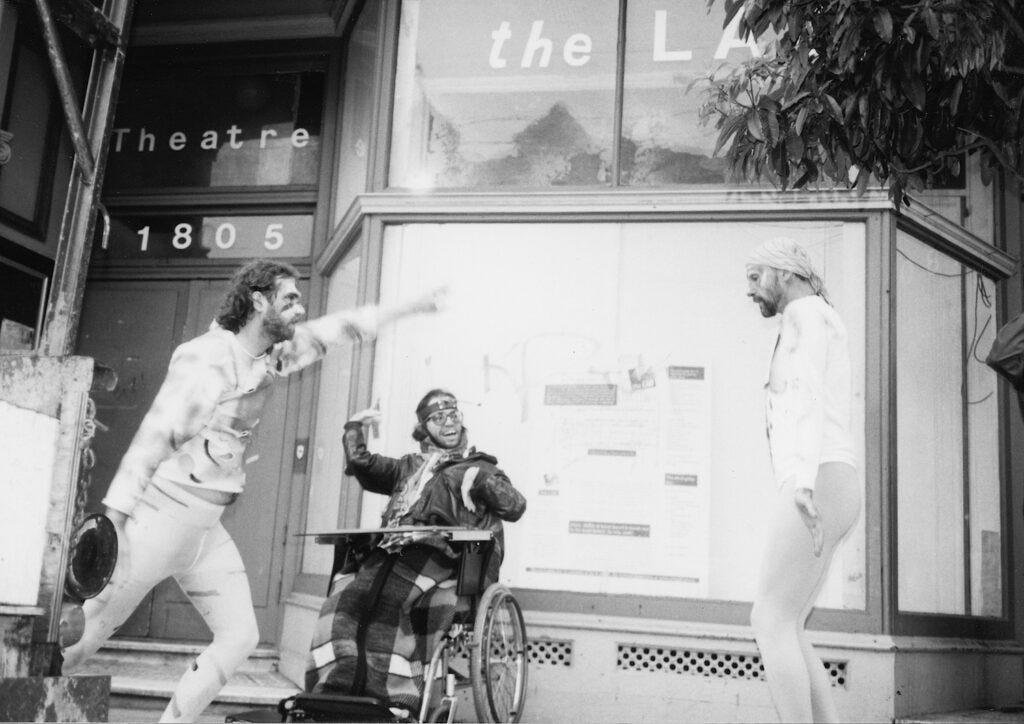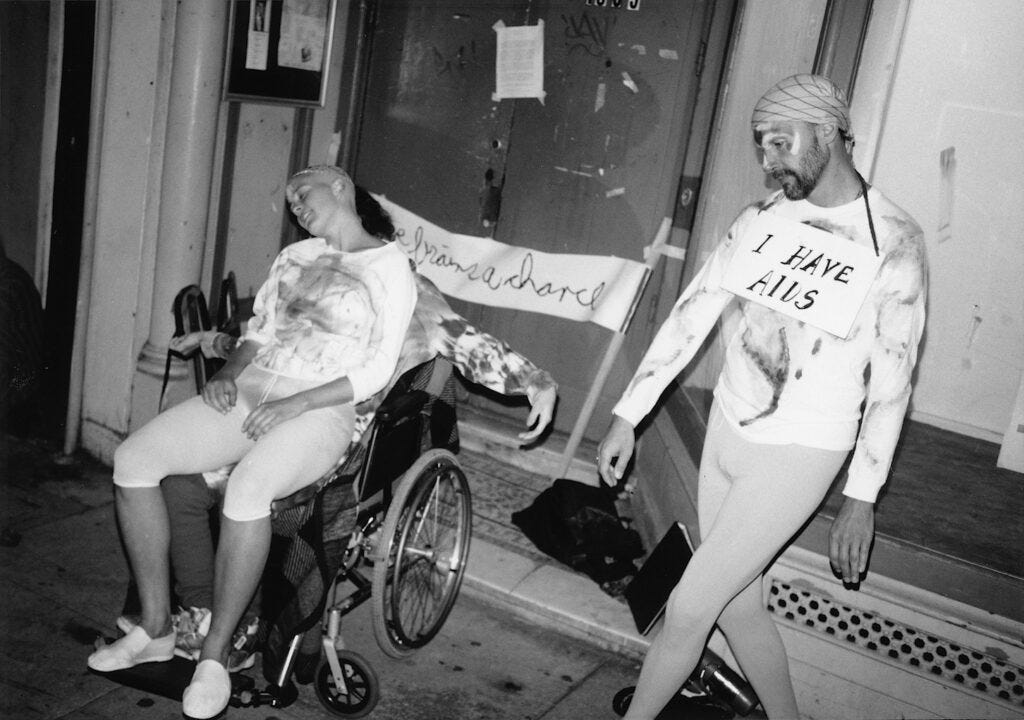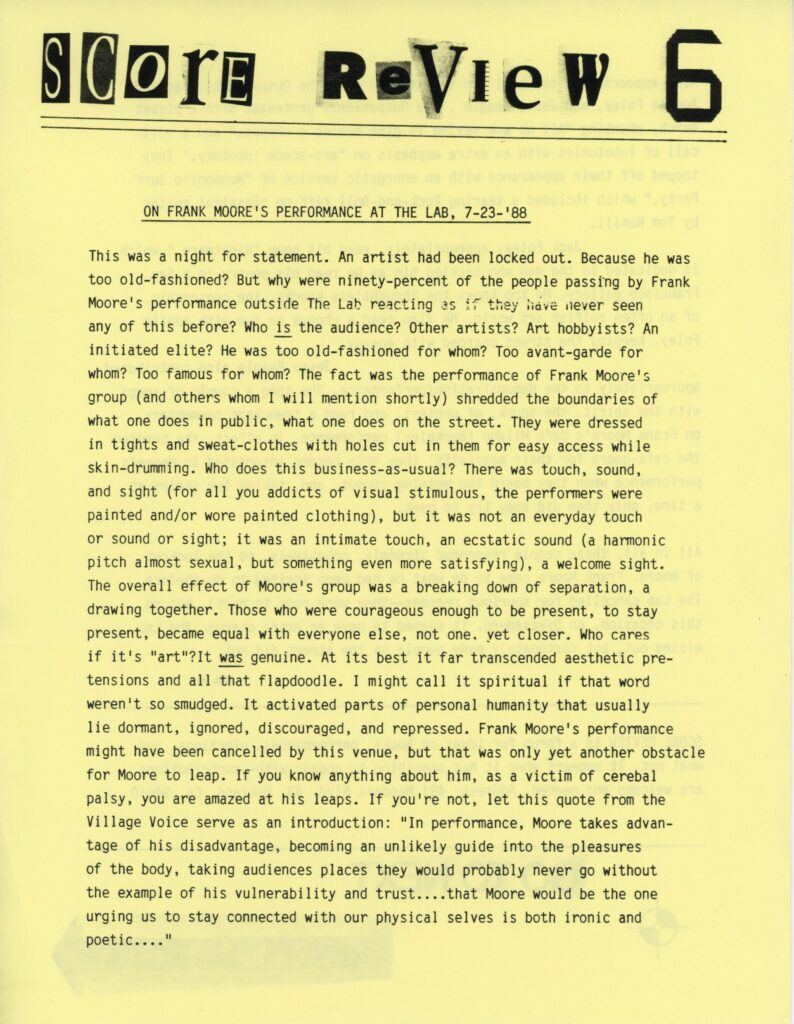SCORE REVIEW 6
ON FRANK MOORE’S PERFORMANCE AT THE LAB, JULY 23, 1988
By Crag Hill
This was a night for statement. An artist had been locked out. Because he was too old-fashioned? But why were ninety percent of the people passing by Frank Moore’s performance outside The Lab reacting as if they have never seen any of this before? Who is the audience? Other artists? Art hobbyists? An initiated elite? He was too old-fashioned for whom? Too avant-garde for whom? Too famous for whom? The fact was the performance of Frank Moore’s group (and others whom I will mention shortly) shredded the boundaries of what one does in public, what one does on the street. They were dressed in tights and sweat-clothes with holes cut in them for easy access while skin-drumming. Who does this business-as-usual? There was touch, sound, and sight (for all you addicts of visual stimulus, the performers were painted and/or wore painted clothing), but it was not an everyday touch or sound or sight; it was an intimate touch, an ecstatic sound (a harmonic pitch almost sexual, but something even more satisfying), a welcome sight. The overall effect of Moore’s group was a breaking down of separation, a drawing together. Those who were courageous enough to be present, to stay present, became equal with everyone else, not one, yet closer. Who cares if it’s “art”? It was genuine. At its best it far transcended aesthetic pretensions and all that flapdoodle. I might call it spiritual if that word weren’t so smudged. It activated parts of personal humanity that usually lie dormant, ignored, discouraged, and repressed. Frank Moore’s performance might have been cancelled by this venue, but that was only yet another obstacle for Moore to leap. If you know anything about him, as a victim of cerebral palsy, you are amazed at his leaps. If you’re not, let this quote from the Village Voice serve as an introduction: “In performance, Moore takes advantage of his disadvantage, becoming an unlikely guide into the pleasures of the body, taking audiences places they would probably never go without the example of his vulnerability and trust….that Moore would be the one urging us to stay connected with our physical selves is both ironic and poetic….”
Also appearing on the bill (on the street) were The Outpatients, Jack and Adelle Foley, and Jesse Beagle. The Outpatients protested with a picket march, chanting “All we are saying is give brains a chance,” and a rollcall of lobotomies with an extra emphasis on “art-scene lobotomy.” They topped off their appearance with an energetic version of “Mennonite Surf Party,” which included a searing Rock-and-Roll riff on classical guitar by Tom Hamill.
Jack Foley, appropriately, read his poem “Nightmare,” which is dedicated to the man who tackled him as he read his poetry in a San Francisco gallery. He too knows the thoughtless knocks, the censorship, of an often selfish art world. He also read a chorus or two with Adelle Foley, keeping the street charged with energy.
Jesse Beagle also contributed appropriately to the demonstration/performance. She sang a couple of songs with the spirit, the spunk, of protest, and read a trenchant commentary on Frank Moore’s Café Milano (Berkeley) performance. In effect, she berated the café-goers for their passivity; they only became interested in Moore’s performance when they heard the moaning sounds, and, taking two stairs at a time, only then did they try to peek.
All in all, these people responded strongly, cohesively, to the lockout of Moore. Frank Moore came to do what he had been invited to do (before The Lab cancelled for spurious reasons—they were rude to boot), but on this occasion, on Divisadero, it seemed to have an extra charge. The Lab missed out, but fortunately many people on the street did not.
SCORE REVIEW is a forum for ideas on books, performance, elections, and what not. It appears when it has something to appear with—contributions are welcome and needed. Oakland, California.
Photos from the performance outside The Lab.
The original newsletter
And of course, as everybody knows who has ever played at games, the ones that are the most fun – to lose as well as win – are the ones that are the hardest, with the most complicated, even dangerous, tasks to accomplish. And so it is that artists are generally not content, either in the Orient or in the Occident, with doing merely simple things – and much soon becomes simple for an artist that for the rest of us would be difficult. The artist seeks the challenge, the difficult thing to do; for his basic approach to life is not of work but of play.”
Joseph Campbell, MYTHS TO LIVE BY, page 126.









